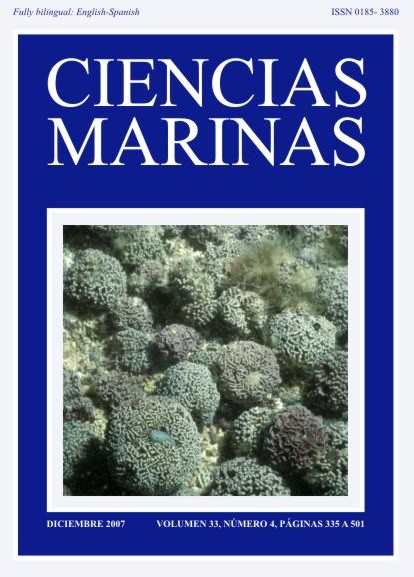Diversity and natural history of a Lithothamnion muelleri-Sargassum horridum community in the Gulf of California
Main Article Content
Abstract
We quantitatively assessed the relative contribution of the rhodolith form of Lithothamnion muelleri, a likely foundation species, to macroorganism diversity in a community also inhabited by the large fucalean Sargassum horridum at a site near Cabo Los Machos at the mouth of Bahía Concepción, Baja California Sur, Mexico. The composition and abundance of seaweeds, epibenthic invertebrates, and fish were estimated in March and October 2003, and invertebrates within rhodoliths (cryptofauna) in March 2003. Rhodoliths and Sargassum horridum had the highest cover of all organisms within the 0.5-km2, 2–8-m-deep cobble-sand site. A total of 29 species of seaweeds, 40 taxa of benthic invertebrates, and 33 species of fish were sampled in transects and quadrats. Macroalgal and fish diversity were similar between sampling times as a result of loss and replacement of taxa, but benthic invertebrate diversity declined without replacement from March to October. Rhodolith cover was similar at both sampling times. The cover and density of S. horridum were highly seasonal, and the non-rhodolith flora changed from abundant S. horridum (35% cover) in March to abundant red algal turf in October (22% cover). The sea urchin Arbacia incisa, tunicates, and polychaetes were the most abundant epibenthic invertebrates in March, but declined by October, the former to zero. Grunts (Haemulon maculicauda) and porgies (Calamus brachysomus) were the most abundant fish at both sampling times, but there were large temporal changes in some other species, especially schooling fishes. Rhodolith density in March was 24 ind m–2, with numerous individuals >8 cm diameter. Fifteen rhodoliths from a range of size classes contained 114 cryptofaunal taxa with an average of 40 taxa/individual in the largest rhodoliths. These results show the importance of rhodolith habitat to diversity, the large temporal changes in some assemblages, and the exceptionally high diversity of this subtropical community.
Downloads
Article Details
This is an open access article distributed under a Creative Commons Attribution 4.0 License, which allows you to share and adapt the work, as long as you give appropriate credit to the original author(s) and the source, provide a link to the Creative Commons license, and indicate if changes were made. Figures, tables and other elements in the article are included in the article’s CC BY 4.0 license, unless otherwise indicated. The journal title is protected by copyrights and not subject to this license. Full license deed can be viewed here.

